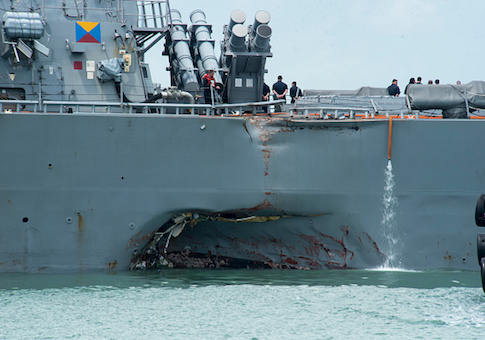Repairs to the two Navy destroyers damaged in separate collisions over a two-month span this summer will cost taxpayers an estimated $600 million, Senate Armed Services Committee Chairman John McCain (R., Ariz.) said on Tuesday.
The figure was provided to Congress by Naval Sea Systems Command, a committee staffer confirmed to the Washington Free Beacon. NAVSEA was unable to provide the cost breakdown at the time of publication.
The Navy plans to transport the USS John S. McCain to Japan by the end of the month for a full damage assessment after it collided with an oil tanker on Aug. 21, leaving 10 U.S. sailors dead. The USS Fitzgerald, which was involved in a June 13 collision that resulted in the death of seven sailors, will be moved from Japan to the United States at the end of October to undergo further repairs. A cost assessment for the Fitzgerald is not yet available.
In opening remarks before the Senate Armed Services Committee, McCain said the absence of the McCain and Fitzgerald from America's Japan-based 7th fleet will impose additional costs on taxpayers due to the unexpected deployments now needed to meet operational demands.
Adm. Harry Harris, chief of the U.S. Pacific Command, told the Japan Times earlier this month the Navy will replace the damaged ships within the next year. Harris said the USS Milius destroyer based in San Diego will be assigned to the 7th Fleet next year, along with another destroyer deployed from either San Diego or Hawaii.
McCain warned of "serious questions about our maritime readiness to fight in response to North Korean, Chinese, and Russian aggression" given that three of the ships involved in the collisions are now out of service for "months to years."
"It is simply unacceptable for U.S. Navy ships to run aground or collide with other ships—and to have four such incidents in the span of seven months is truly alarming," McCain said.
The hearing featured testimony from top Naval officials, who tried to make sense of the collisions while grieving family members looked on.
Adm. John Richardson, chief of naval operations, said he did not yet have an explanation for the collisions amid pending investigations, but blamed a failure of command within the service as a contributing factor.
"I am accountable for the safe and effective operations of our Navy, and we will fix this. I own this problem," Richardson testified.
The panel widely condemned the collisions as preventable, citing nearly a decade of budget constraints that have strangled the U.S. military. The Navy's responsibility to meet the increased demand for an American military in the Pacific has forced the service to scale back on training, delay maintenance, and frequently extend deployments, officials said.
Richardson said the Navy was in the process of assessing leadership failures, safety standards, and ship certifications. The Navy has so far fired six senior officers due to a "loss of confidence in their ability to command" following the series of collisions.
